- Established 1982 -HOME: www.hiltonpond.org
THIS WEEK at HILTON POND Subscribe for free to our award-winning nature newsletter (Back to Preceding Week; on to Next Week) |
MOUNTAINS vs. PIEDMONT:
The photo essay below is in two parts, the first about our time at the Festival and the other describing Hilton Pond happenings in May 2018.
All text, maps, charts & photos © Hilton Pond Center The New River, namesake for the annual New River Birding and Nature Festival, provides ever-changing and inspirational views from sunrise (above) to sunset. Fayette County WV, where the Festival is based, is also home to the famous New River Gorge Bridge on U.S. 19. All text, maps, charts & photos © Hilton Pond Center
All text, maps, charts & photos © Hilton Pond Center The first morning of the New River Birding and Nature Festival is devoted to "birding by butt," when participants gather at Opossum Creek Retreat for breakfast and short walking field trips with expert guides. Our job that morning is to run mist nets and traps to give folks a different in-hand view of birds they normally see only through binoculars and camera lenses. One bird we caught that day was a male Ruby-throated hummingbird (above). Amazingly, we banded this hummer as an adult two years previously at the 2016 Festival, making him an after-third-year bird with numerous Neotropical trips down and back to his credit. All text, maps, charts & photos © Hilton Pond Center
All text, maps, charts & photos © Hilton Pond Center Rides through West Virginia's scenic countryside in sleek and shiny transportation (i.e., converted school buses) are always a highlight, giving Festival participants from California to Canada ample opportunity to talk about birds and other things. Daily field trips go to top nature locales in Fayette and surrounding counties, visiting sites as diverse as Cranberry Glades Botanical Area and "reclaimed" strip mines--all of which make for an optimal number of bird sightings during the week. The Glades is the southernmost breeding locale for birds usually found much further north (e.g., Swainson's Thrush, Mourning Warbler, and Purple Finch), while entirely different bird species (particularly the sought-after Golden-winged Warbler) are found in the early successional vegetation now growing in reclaimed soil where coal-rich land had been removed down to bedrock.
All text, maps, charts & photos © Hilton Pond Center One Festival field trip stops at Babcock State Park near Clifftop WV, home of the picturesque Glade Creek Grist Mill (above). It's a fully functional replica of the original Cooper’s Mill at which visitors these days can watch the corn-milling process most weekends. Scattered throughout nearby woods, several rustic but comfortable cabins with wood-burning fireplaces provide great places for a retreat back in time.
All text, maps, charts & photos © Hilton Pond Center Below the old mill at Babcock is a wall of massive stone blocks placed in the 1930s by the Civilian Conservation Corps to create a swimming pool and water reservoir. In a crevice between the stones we spotted a nest being tended by a pair of Northern Rough-winged Swallows (above). These Neotropical migrants--named for small "serrated" barbs on their outermost primary feathers--spend our winter primarily in Mexico and Central America, returning in early spring to feed on flying insects. Although not visible in our photo, buffiness on neck and breast is the diagnostic field mark for this fast-flying species. All text, maps, charts & photos © Hilton Pond Center
All text, maps, charts & photos © Hilton Pond Center One of the most abundant late spring wildflowers in West Virginia is Golden Ragwort, Packera aurea (above), formerly Senecio aureus. This native sunflower is so ubiquitous along rural roadsides and elsewhere that observers often assume it is an invasive non-native, which it is not. Occurring naturally from eastern North America to Texas, it thrives in sun-dappled places. Its flat-topped clusters of one-inch yellow flowers brighten many a shady spot in the mountains of West Virginia. Golden Ragwort--pollinated by several species of small native bees--is a host plant for caterpillars of Northern Metalmark Butterflies. Its foliage is reportedly toxic to most herbivores except sheep. All text, maps, charts & photos © Hilton Pond Center
All text, maps, charts & photos © Hilton Pond Center Another common yellow sunflower along West Virginia byways is Coltsfoot, Tussilago farfara (above). Although this plant's hoof-shaped leaves are a common sight on gravel roadsides for Festival-goers in May, it typically blooms in early spring before they come to town. Unlike Golden Ragwort, Coltsfoot is an interloper from Europe and western Asia; it has a long-lived deep rhizome and often crowds out native plants. Coltsfoot's genus name comes from from the Latin words tussis (cough) and ago (to act upon), apparently because the plant was used in medieval times (and later) as treatment for respiratory ailments. It is pollinated primarily by bees, beetles, and Flower Flies. All text, maps, charts & photos © Hilton Pond Center
All text, maps, charts & photos © Hilton Pond Center One of the most easily observed warblers during the Festival was the American Redstart, highly visible in trees that had not quite leafed out . (Budburst was very late in West Virginia this spring.) The male redstart (above) is Halloweenish in color, with his jet black plumage highlighted by bright orange. The female has the same pattern, but black is replaced by olive green, and orange by yellow. (Young males resemble females, with accents that often are more salmon-colored.) As they feed redstarts constantly open and close their tails, possibly as a flash that startles insects and makes them more catchable. American Redstarts breed primarily in eastern North America but range into the Midwest and even western Canada, with numerous disjoint populations throughout the range. They winter throughout Central America and the Caribbean and in northern South America. All text, maps, charts & photos © Hilton Pond Center
All text, maps, charts & photos © Hilton Pond Center Squirrel Corn, Dicentra canadensis (above), is an unusually shaped native wildflower that occurs on rocky outcroppings covered by rich soil. The leaves are fern-like. This species is sometimes confused with congeneric Dutchman's Breeches, D. cucullaria, which occupies the same habitat but blooms even earlier in spring. It also resembles closely related Bleeding Heart, Lamprocapnos spectabilis, (formerly D. spectabilis), a non-native from Asia that is larger and pale pink in color. Botanists report Squirrel Corn is susceptible to being crowded out by several invasive plant species and apparently even is threatened by non-native earthworms that churn the soil and disturb its roots. It is a host plant for caterpillars of fritillary butterflies and is pollinated by Bumblebees, Bombus spp. All text, maps, charts & photos © Hilton Pond Center
All text, maps, charts & photos © Hilton Pond Center One new naturalist at the New River Festival this year was Christina Baal, an up-and-coming wildlife artist whose goal is "Drawing 10,000 Birds" from around the world. Shown above with her vibrant renderings of Bald Eagle and "Snake Falcon," she has just begun her project and through May 2018 has "met" 834 species and "drawn" 252. So why is she doing this? Christina responds: "I truly hope my journey to find all of the birds of the world and the art that comes out of it will be the way in which I can connect with people to show them the awesomeness of the natural world, that we are irrevocably a part of it, and, ultimately, that we must work together with each other and the living creatures we live alongside to protect it."
All text, maps, charts & photos © Hilton Pond Center Knowing about our long-time research with Ruby-throated Hummingbirds, Christina was kind enough to give us a print (above) depicting her interpretation of this hyper-kinetic species feeding on Red Columbine. Her international endeavor of Drawing 10,000 Birds is supported in large part by sales of these prints and greeting cards based on her drawings and paintings. All text, maps, charts & photos © Hilton Pond Center
All text, maps, charts & photos © Hilton Pond Center Despite their abundance and wide-spread distribution, Wild Geranium, Geranium maculatum (above), is one of our all-time favorite native wildflowers. Their rich purple blossoms can be found in rich shady woodlands almost anywhere across the U.S. and Canada east of the Rockies, excepting subtropical Florida. Wild Geranium's alternate common name of Cranesbill and the genus epithet both reflect the Greek word geranos (a crane) because its seed capsule resembles a crane's long bill. Wild Geranium nectar and pollen are sought by flies, beetles, and bees (including Cuckoo Bees, Sweat Bees, and smaller Carpenter Bees); in the absence of these insects the flowers may still self-pollinate. The plant's foliage provides food for several native moth species. All text, maps, charts & photos © Hilton Pond Center
All text, maps, charts & photos © Hilton Pond Center Eastern Comma, Polygonia comma (above), is an aggressive butterfly. Males perch on tree trunks and chase after females and other flying creatures, including birds. There are two generations each year for this species, one of which overwinters and lays eggs in spring. These eggs hatch into adults laying summer eggs that, in turn, hatch into the winter form. (Some adults migrate an unknown distance south before hibernating.) Well-worn wings on the individual in our May photo indicates it overwintered as an adult. The Eastern Comma's caterpillar is a solitary night feeder that sometimes creates a daylight hiding space by pulling a leaf around itself and sealing the opening with silk. Larvae dine on foliage of elm trees and nettles, while adults use their probosces to suck up tree sap and juices from rotten berries and other fruit. All text, maps, charts & photos © Hilton Pond Center
All text, maps, charts & photos © Hilton Pond Center Two kinds of plants found in West Virginia are known commonly as "chickweed"--those classified in the related genera Stellaria and Cerastium. Worldwide there are perhaps 90-120 species of the former and 200-plus of the latter. Such diversity often makes positive identification of chickweeds a bit problematic. One thing they all have in common is they appear to have ten white petals but really only have five--each one split almost to the base. We're making a flying leap of faith on the plant in our photo above and calling it Common Chickweed, Stellaria media, an annual that originated in Europe and that is considered to be naturalized and invasive. As the name suggests, chickweed seeds--usually produced via self-pollination--are eaten by many species of birds from dove to quail and sparrows to finches. Uneaten seeds are known to remain viable in the ground for at least a quarter century, so once you have chickweed you'll probably always have chickweed no matter how much you pull or cut it. Although Common Chickweed is an alien species that did not co-evolve with native butterflies and moths, larvae of several North American lepidopterans now seem adapted to foraging successfully on its leaves. All text, maps, charts & photos © Hilton Pond Center
All text, maps, charts & photos © Hilton Pond Center It might not be the most abundant salamander in West Virginia, but Red-spotted Newt, Notophthalmus viridescens, is by far the most noticeable--at least in its terrestrial "eft" stage (above). This species lays its eggs in ponds and slow-moving streams, where they hatch into tiny quarter-inch gilled larvae. At about three months they metamorphose, losing gills and gaining lungs and legs and bright red bodies as they crawl onto land. Efts wander about eating worms or other invertebrates for 2-3 years, finally returning to aquatic habitats where they retain their lungs but trade for a laterally flattened swimming tail and olive green coloration--with red spots all that remain of their colorful past. Adults prey upon eggs of fish and other salamanders and also take aquatic worms and small crustaceans. All text, maps, charts & photos © Hilton Pond Center
All text, maps, charts & photos © Hilton Pond Center Plantain-leaved Pussytoes, Antennaria plantaginifolia (above), is so-named because its flower head resembles a cat's paw. It is a diminutive 6" tall perennial native wildflower in which individual plants are dioecious, i.e., either male (staminate) or female (pistillate). It flourishes in poor soil under sunny conditions where other natives sometimes have trouble competing with invasive species. Pussytoes pollination is by small bees and a variety of flies--including syrphids and Blow Flies, Flesh Flies, and Muscid Flies attracted by the flowers' somewhat rancid odor. Painted Lady caterpillars forage on its leaves, as do larvae of Everlasting Tebenna Moth. Despite its appearance, all the Pussytoes are classified in the Asteraceae--the Aster Family--making it technically a "sunflower." All text, maps, charts & photos © Hilton Pond Center
All text, maps, charts & photos © Hilton Pond Center On the final day of each West Virginia festival we typically take a group to New River Birding & Nature Center between Oak Hill and Fayetteville, a place dear to our hearts because of many weeks we spent there overseeing construction of a Wolf Creek Wetlands Boardwalk. Festival participants wander out on trails while--in collaboration with local bander Keith Richardson--we deploy mist nets to see what birds we can capture for up-close views when the birders return. This year the wetlands were damp and gray, with intermittent showers causing us to shut and re-open the nets several times. Watching us work was a lonely Turkey Vulture perched on a snag (above), hunched down to stay as dry as possible under a slow drizzle.
All text, maps, charts & photos © Hilton Pond Center As Keith and I took shelter under a gazebo we were surprised to see a couple of Solitary Sandpipers fly in and descend onto bare soil surrounding a small beaver pond directly in front of us. The little waders were seemingly oblivious to our presence, going about their business probing soft mud for invertebrates. Constantly bobbing their tails, the sandpipers occasionally eased into shallow water and one even hopped onto an exposed log for the photo above. Solitary Sandpipers are long-distance migrants that were stopping only briefly to refuel. They breed in far northern Canada and Alaska and migrate to southern Mexico, Central America, and northern South America for cold weather months. The ones we saw in this West Virginia wetlands oasis were in breeding plumage on their way north. Note the bird's long toes that help keep it from sinking into soft substrates. Interesting factoid: Although they are technically "shorebirds," Solitary Sandpipers lay their eggs in abandoned tree nests of various songbirds; they and Eurasia's Green Sandpiper are the only two of 85 sandpipers worldwide that are not ground nesters. All text, maps, charts & photos © Hilton Pond Center
All text, maps, charts & photos © Hilton Pond Center With birds taking shelter from the intermittent rains, we caught few individuals in the Wolf Creek Wetlands--normally a very productive banding locale. Of note was a female Canada Warbler (above) with her white and yellow eye ring, gray head and back, and black necklace. As suggested by its name, this warbler nests primarily in eastern Canada and very northeastern U.S. states, but there are scattered breeding populations along the Appalachian chain. They hang out primarily in the understory, where they flick wings and tails as they hop from branch to branch seeking caterpillars and other insects. Canada Warblers are among the last parulids to arrive in spring and one of the first to depart in early autumn. All text, maps, charts & photos © Hilton Pond Center
All text, maps, charts & photos © Hilton Pond Center Also of interest in our nets was an aptly named Hooded Warbler, a bright yellow bird with black crown and cowl. This individual was a male--females and immature males are similar but usually with much paler hoods--and we determined he was a second-year bird because of worn and acute rectrices, "immature" wing covert feathers, and a single yellow feather on his throat. Also visible in the photo are the warbler's rictal bristles, modified hair-like feathers that likely protect his eyes while swallowing wriggly caterpillars. This is a truly eastern bird that breeds primarily from Pennsylvania south to northern Florida and west to East Texas, wintering in Cuba and along the Caribbean edge of Mexico and Central America. Hooded Warblers show great site fidelity; banding records show they can live up to eight years, returning season after season to the very same breeding area. All text, maps, charts & photos © Hilton Pond Center
All text, maps, charts & photos © Hilton Pond Center On our final afternoon in Fayette County we headed for the Canyon Rim Visitor Center north of Fayetteville, where one can get memorable views of the famous New River Gorge Bridge and the river itself. The photo above shows low hanging clouds across the gorge, indicative of our gray day. If we could greatly enlarge the photo you likely would see folks floating down the river in rafts--a pastime for which this locale is world famous. All text, maps, charts & photos © Hilton Pond Center We departed the mountains around Fayette County WV and the New River Birding and Nature Festival on 6 May in time to make it to Hickory NC for the seventh birthday party of granddaughter McKinley Ballard Hilton, whose favorite avifauna just happens to be hummingbirds. After that exciting event it was finally home to Hilton Pond Center and the Carolina Piedmont, where our first task after a week's absence was to fill feeders with seeds or artificial nectar. We were glad none of the feeders were completely empty and imagine the hummers appreciated our providing sparkling fresh sugar water.
All text, maps, charts & photos © Hilton Pond Center It was back to business on the morning of 7 May 2018 at Hilton Pond. We were up early to unfurl mist nets hoping to band a few migrant songbirds at our home base, but things were a little slow. Shortly before lunch wife Sue Ballard Hilton was peering out the kitchen window and gasped that a baby owl was perched on an old Muscadine vine. A quick look through binoculars confirmed her conjecture, and the owlet's dark eyes meant it had to be a young Barred Owl. (Our other Piedmont owls have yellow irises.) We were able to walk within ten feet of the little owl and got several full-frame photographs with a 400mm lens (see photo above). The owlet stared at us while we stared back at it, sitting motionless on the vine. The slightly bedraggled chick held tight with what were already fully grown toes with sharp talons. Legs and feet develop very quickly in young birds--the better to hold fast and keep a youngster from falling out of the nest. Alas, we think this owlet had failed at that very task. Its feathers were matted and looked damp, so we're guessing it fell from its nest high up in a tree, bounced softly on the lawn beneath, and walked to the nearest Muscadine vine before ascending with strong toes and claws. Wife Susan watched the owl on and off for most of the afternoon, noticing that for a while it went prostrate on the vine as if sleeping. The bird changed position a few times, occasionally flapping its stubby, undeveloped wings. When we went back out to check at dusk, an adult Barred Owl swooped over and landed 25 yards away in the canopy. It was then we could hear a soft "toot-toot" that almost certainly was the adult communicating with its offspring--perhaps saying "Be still!" because a perceived enemy was near. We've heard the Barred Owl's "Who cooks for you, Who cooks for you all" countless times, but this mysterious two-note call was new. In a previous installment we posted a photo of one of our local Barred Owls (above right), undoubtedly the father of the chick Susan spotted. Our newly found immature owlet is likely to be tended by both parents, even though it's no longer in a nest. The adults had already invested far too much time and energy to give up on their lively little chick just because it fledged prematurely.
POSTSCRIPT: On 11 May (four days after finding the owl chick) we were walking our trails with longtime friend Bob Shockey and wife Diane, come to visit Hilton Pond for the first time. As we rounded a curve we spotted another flightless fledgling Barred Owl, this one sitting in the grass in full sun. After Bob took a few photos with his cell phone we wandered away, leaving the owl unmolested. When the Shockeys bid adieu we went back out with our regular camera to see how the owlet was doing and snapped the photo above. By now the bird had moved under a low-growing shrub, out of the sun and less obvious to potential predators. This second fledgling was much less downy than the previous one and seemed further along in development. Try as we might, we can't tell for sure if the two photos taken less than a week apart depict two owlets out of the nest or just one that was growing very fast. All text, maps, charts & photos © Hilton Pond Center Bird artist and field guide innovator Roger Tory Peterson did us no favors in coining the phrase "confusing fall warblers." Such commentary strikes fear in the hearts of beginning birders and makes identifying warblers NOT in breeding plumage seem harder than it really is. What Peterson SHOULD have said was that several Tyrant Flycatchers (Tyrannidae) are almost impossible to separate in the eastern U.S. without running a DNA sample. We exaggerate, of course, but flycatchers do present a dilemma. The bigger ones such as Eastern Kingbird, Great Crested Flycatcher, and Eastern Phoebe are easily identified, but those smaller species in the Empidonax and Contopus genera are a whole 'nother matter.
All text, maps, charts & photos © Hilton Pond Center All these small flycatchers have olive-greenish backs and grayish breasts. Of the four eastern Empidonax flycatchers (with their eye rings and light wing bars), only the Acadian breeds in the Southeast; except during migration you can confidently differentiate it from Yellow-Bellied, Traill's, and Least Flycatchers--all of which are best identified by song or chip call. Of the Contopus species, only the Eastern Wood-Pewee and husky Olive-side Flycatcher occur in the Carolinas, where the latter is a very rare migrant. We were reminded about flycatchers on 8 May when we caught one in a mist net at Hilton Pond Center. We first looked for an eye ring and upon finding none ruled out the Empidonax group. Eastern Phoebes are common here, but they have black bills. Since the newly captured bird had a bright yellow lower mandible, that left Eastern Wood-Pewee as the positive I.D. for the bird in-hand. (See how easy that was?!) That's the pewee in our photo above. Again, note the yellow lower mandible and lack of an eye ring. The near-macro image even shows the tip of the upper mandible has a hook on the end, small to us but pretty big--and deadly--to a fly or other insect that gets snapped up by the bill of a hungry Eastern Wood-Pewee's. All text, maps, charts & photos © Hilton Pond Center On 11 May we mist netted at Hilton Pond Center a Neotropical species we greatly enjoy observing and banding: A second-year male Indigo Bunting. We've always thought the epithet "indigo" didn't really do justice to the wide variance of hues in this bird's feathers. Indigo is certainly visible, but numerous other subtle shades of blue are nearly indescribable, and any photo fails to do justice to such striking plumage.
All text, maps, charts & photos © Hilton Pond Center The curious part is that Indigo Buntings are not blue in the first place. They're actually BLACK--as shown by centers of the alular feathers at the bend of the wing (photo above) and by the hint of a mask ahead of the bird's eye. This black comes from melanin pigment--the same compound that causes human skin to tan upon exposure to ultraviolet light. Melanin is the base pigment, but there is no BLUE pigment in an Indigo Bunting--or in a Blue Jay or Eastern Bluebird. The apparent blue color is the result of tiny air bubbles and grooves in the birds' feathers. When light strikes these structures, all wavelengths except blue are absorbed while blue wavelengths are scattered back to our eyes. Thus, any indigo in a male bunting is a STRUCTURAL color--not a pigment--which is why this bird in deep shade will look almost black. Although Indigo Buntings nest locally--we've often captured females with active brood patches at the Center--many we see here stop only briefly at our sunflower seed feeders in spring and probably head further north as far as southern Canada to breed. Females nest a few feet off the ground in low vegetation while the male chooses the highest nearby perch where he can burst forth with repetitive couplets: "what! what! where? where? see it! see it!" The actual song varies from region to region, but its pattern is unmistakable--especially since the hormonal male repeats his performance over and over, sometimes all day long. All text, maps, charts & photos © Hilton Pond Center
All text, maps, charts & photos © Hilton Pond Center Near-daily precipitation was not conducive to outdoor activities in mid-May at Hilton Pond Center, so when partly cloudy skies occurred on the morning the 19th we were out early to groom some trails that had become overgrown due to all the rain. We also wanted to move the remains of a 60-foot-tall Loblolly Pine that died years ago due to pine bark beetles. The two-foot diameter tree had finally toppled during recent high winds and was blocking a main trail, so we grabbed our whisper-quiet cordless electric chain saw and headed out. Just as we got to the fallen log we witnessed an amazing sight: Hundreds--perhaps thousands--of winged insects moving about in a frenzy. As we approached they started to lift off, and within five minutes all were gone. At first we thought they were flying ants, but instead determined they were the tiny black and winged form of subterranean termites that had made the log their home. Often--on a drier day after periods of rain--these "winged alates" emerge and take to the skies where a male's goal is to find a female he can fertilize, making her a new queen that can start a colony elsewhere. The log was quite easy to cut--large amounts of of wood had been eaten away by the ravenous termites; wood-dwelling ants also appeared to have expanded their own galleries by chewing (but not eating) wood and taking it elsewhere. In a few years the old pine will have decomposed completely, broken down by fungi and ants and digested away by microorganisms that live within the gut of the termites that colonized the log. All text, maps, charts & photos © Hilton Pond Center
All text, maps, charts & photos © Hilton Pond Center So there you have it, accounts of two very different regions of the country--the Appalachian Mountains of West Virginia and South Carolina's Upper Piedmont--each with its own complement of flora and fauna. Neither is better than the other, and both are great places to explore and then write about on a rainy day in May (above) from our home base at Hilton Pond Center for Piedmont Natural History. All text, maps, charts & photos © Hilton Pond Center Don't forget to scroll down for Nature Notes & Photos, 
Checks can be sent to Hilton Pond Center at: All contributions are tax-deductible on your |
|---|
|
"This Week at Hilton Pond" is written and photographed by Bill Hilton Jr., executive director of Hilton Pond Center for Piedmont Natural History
|
|
|
Please refer "This Week at Hilton Pond" to others by clicking on this button: |
Comments or questions about this week's installment? Send an E-mail to INFO. (Be sure to scroll down for a tally of birds banded/recaptured during the period, plus other nature notes.) |

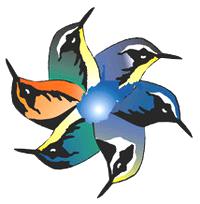


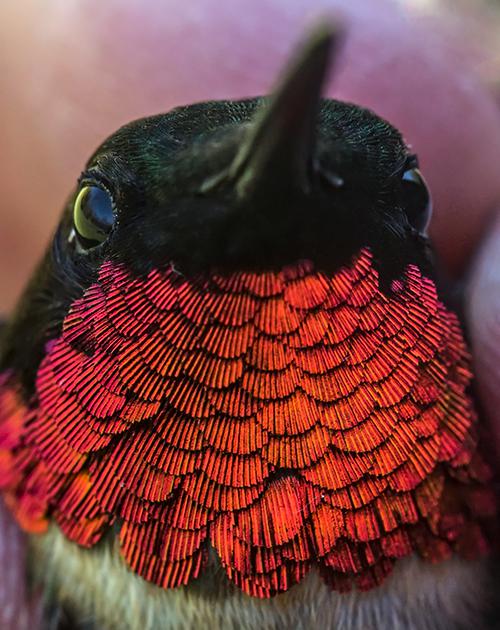
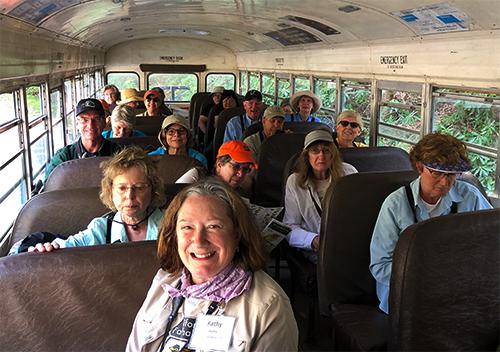
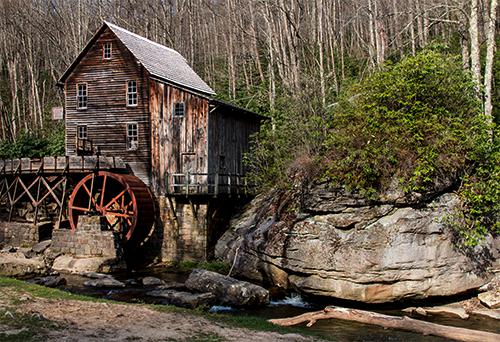
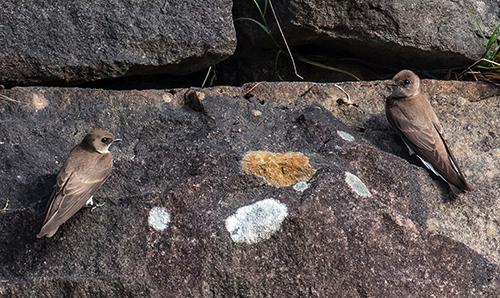

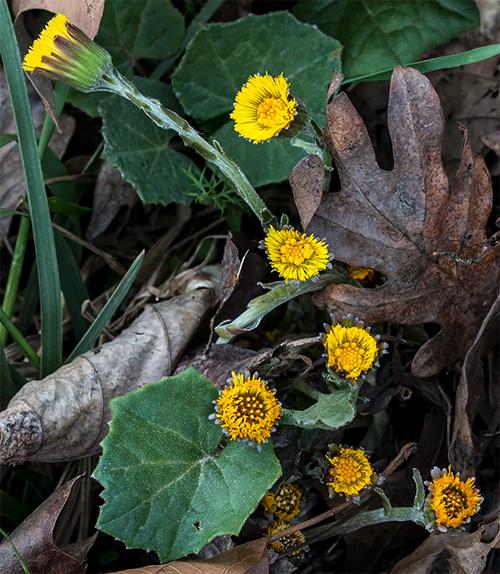

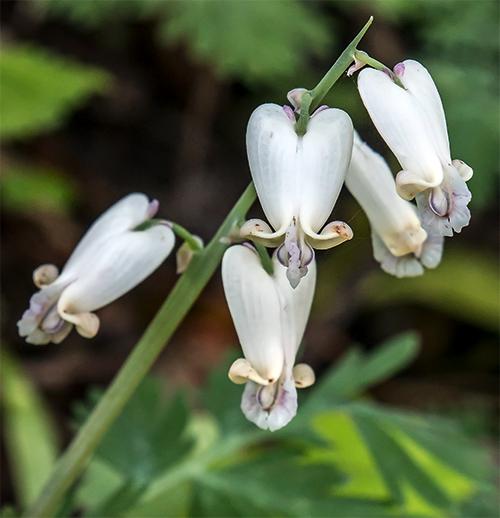
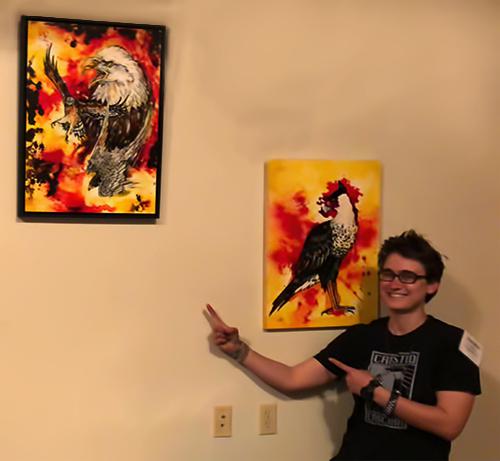
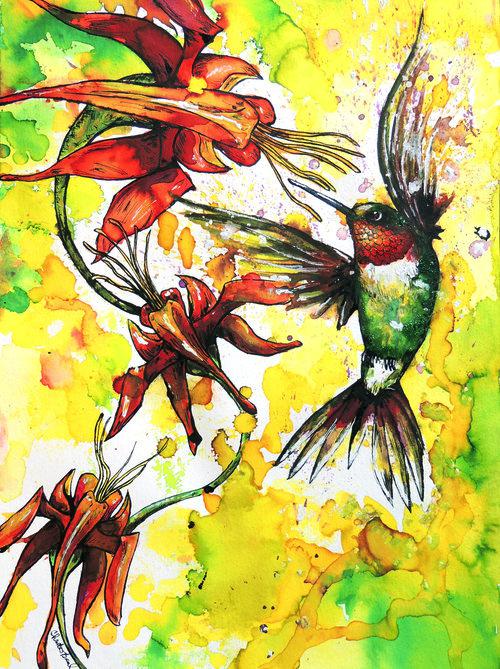
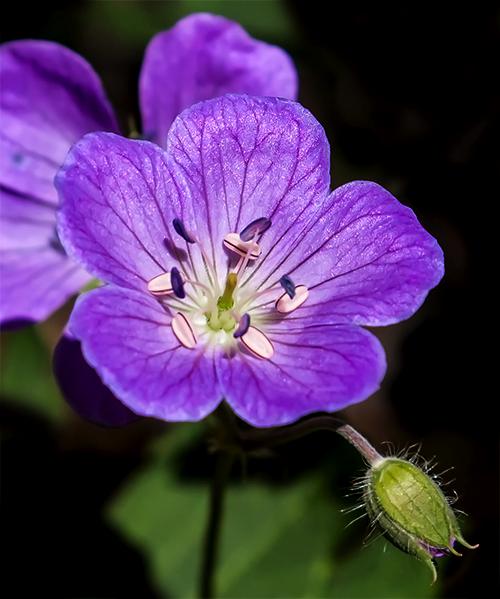

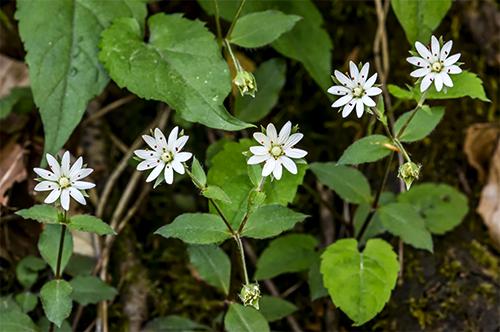
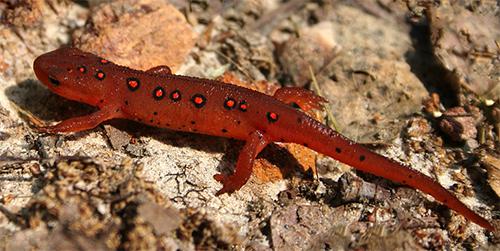

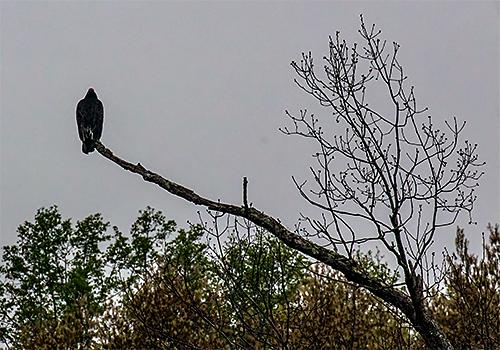


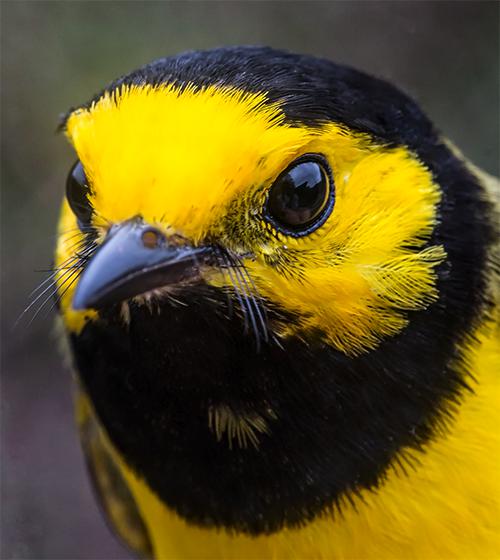
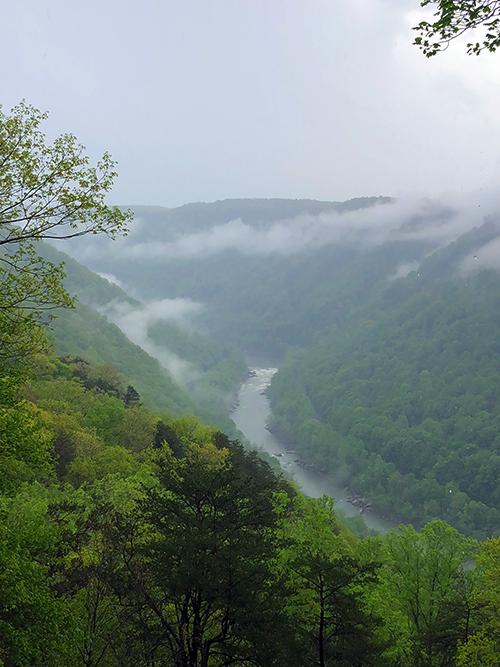

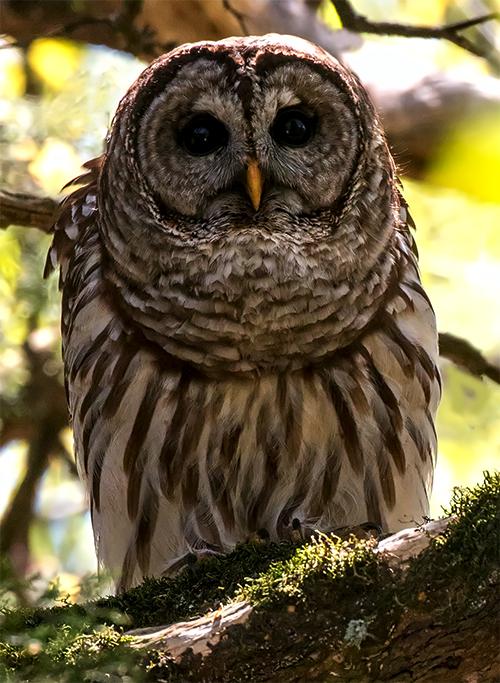 As the sun sank low on the horizon the owlet seemed to get a burst of energy, climbing higher onto the vine and eventually into the supporting tree.
As the sun sank low on the horizon the owlet seemed to get a burst of energy, climbing higher onto the vine and eventually into the supporting tree.
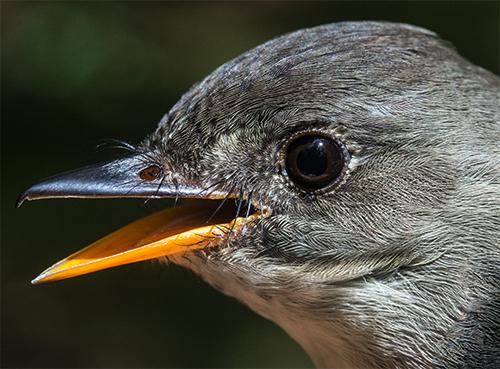
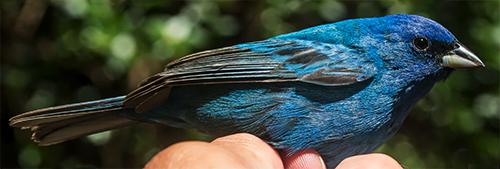
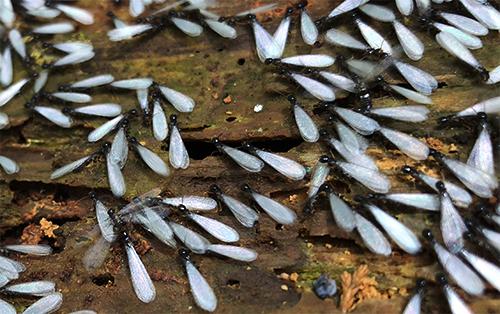
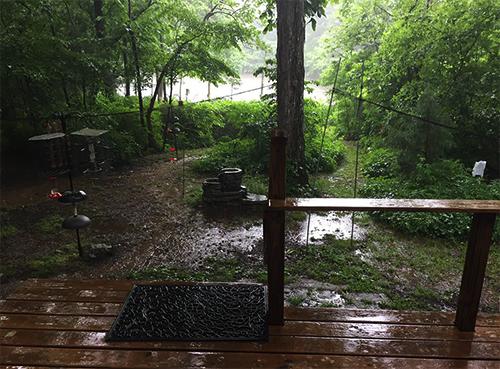








 Please report your
Please report your